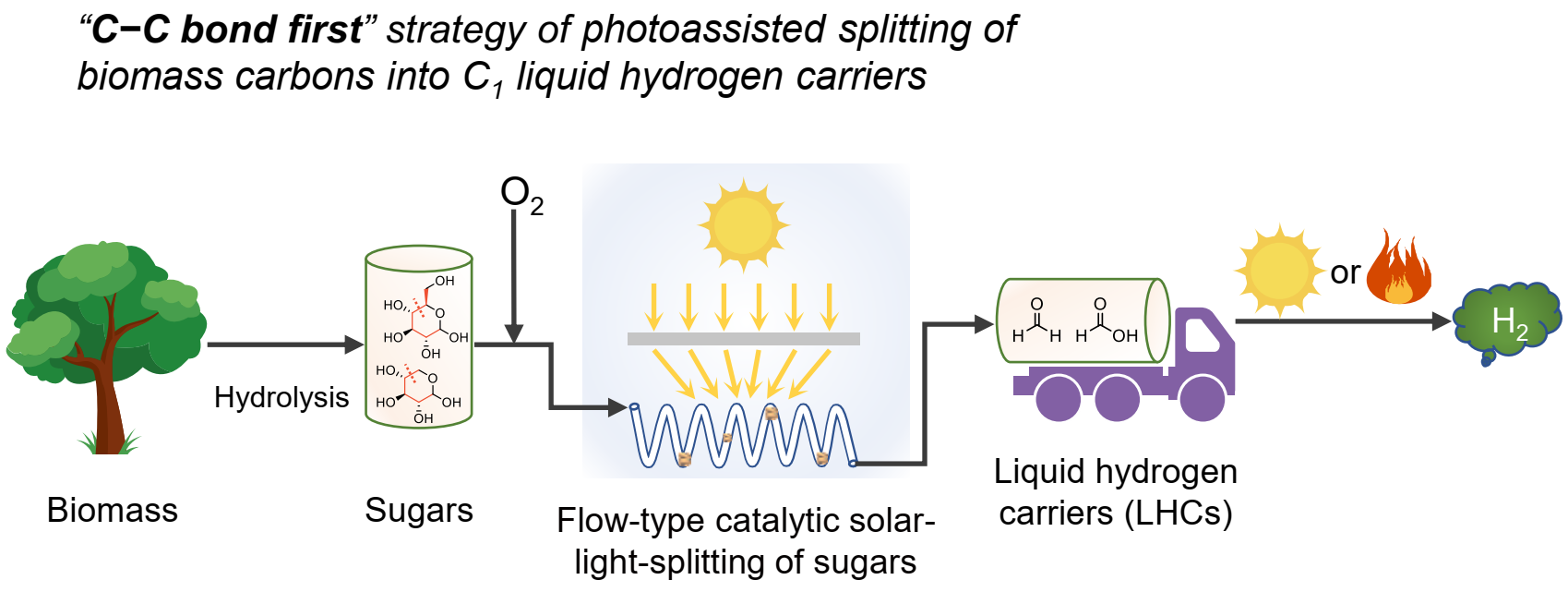Hydrogen (H2) can be produced as a clean energy vector through biomass photoreforming driven by solar light. To maximize H2 production in future biomass refining, biomass photoreforming requires a high decomposition extent of biomass.

Illustration of a stepwise method for H2 production from biomass and storage in the form of C1 LHCs. Image Credit: Nengchao Luo and Puning Ren
Investigators guided by Professor Feng Wang and Dr. Nengchao Luo from the Chinese Academy of Sciences (CAS) Dalian Institute of Chemical Physics (DICP), in partnership with Professor Paolo Fornasiero from the University of Trieste, recently suggested a “C–C bond-first” strategy and realized carbohydrates conversion into C1 liquid hydrogen carriers (LHCs, consisting of HCOOH and HCHO) over Ta-CeO2 photocatalyst.
The LHCs could produce the H2 required for photo- or thermocatalysis on-site.
On January 31st, 2023, the study was published in the journal Joule.
As of now, the major hindrance to high H2 yield is the absence of C–C bond breaking to transform biomass carbons into CO2 while maximizing H2 production.
The scientists revealed the importance of prioritizing the scission of C–C bonds in carbohydrates for photocatalytic hydrogen production and storage.
The suggested “C–C bond first” strategy prioritized biomass conversion to liquid C1 LHCs by breaking the C–C bonds completely. A synergistic Ta-CeO2 that used photo- and thermal energy from solar light completely broke the C–C bonds of carbohydrates, yielding C1 LHCs containing HCOOH and HCHO with yields ranging from 62% to 86%.
Researchers discovered that during the photocatalytic oxidation of carbohydrates, an increased temperature was used to prevent harmful radical coupling over the highly distorted Ta-CeO2. Independent of solar light irradiation, the resulting C1 LHCs that could be moved released only H2 and CO2. The yield of H2 from glucose was 33%, which was significantly higher than the yield from direct photoreformation of glucose.
This stepwise approach was also demonstrated by flow-type photocatalytic oxidation of glucose under concentrated solar light, which facilitated a 15% yield of C1 LHCs from glucose over a 15.5-hour cumulative irradiation time.
This work provides a new perspective for H2 production and storage by emphasizing the significance of the prioritized scission of biomass C–C bonds.
Dr. Nengchao Luo, Dalian Institute of Chemical Physics, Chinese Academy of Sciences
The research was funded by the Ministry of Science and Technology of the People’s Republic of China, the National Natural Science Foundation of China, the Joint Fund of the Yulin University and the Dalian National Laboratory for Clean Energy, and the Italian Ministry of Foreign Affairs and International Cooperation-Project Italy-China n°.
Journal Reference
Ren, P., et al. (2023) Stepwise photoassisted decomposition of carbohydrates to H2. Joule. doi.org/10.1016/j.joule.2023.01.002.